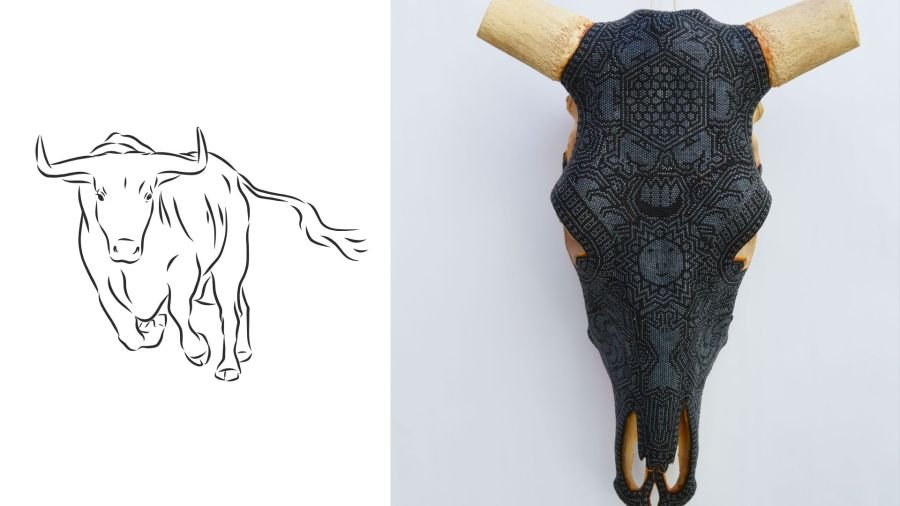
The Charging Bull: A Chaquira Masterpiece of Fear and Majesty
In the quiet solitude of an artist’s workshop, the chaotic energy of a charging bull is meticulously translated into a stunning piece of chaquira beadwork. Each bead, a tiny gem of color and light, is placed with precision and purpose, transforming a simple bull skull into a vibrant tableau of fear and majesty. This art form, rooted in ancient traditions, is not merely a visual spectacle but a profound narrative that captures the essence of the bull’s primal power and the artist’s creative spirit.
The Symbolism of the Charging Bull
The bull, a symbol of strength, virility, and unyielding power, has been a prominent figure in various cultures throughout history. When depicted charging, it embodies raw emotion and instinctive reaction, reflecting the universal themes of fear, courage, and survival. For the Huichol people, who have long revered the natural world and its inhabitants, the bull represents not only physical might but also spiritual energy and resilience.
The Art of Chaquira: Crafting with Precision
Creating chaquira beadwork is an art form that demands patience, skill, and a deep understanding of symbolism. The process begins with a vision—a mental image of the charging bull, its muscles rippling with tension, its eyes wide with determination. The artist, often guided by traditional knowledge and personal intuition, selects a palette of beads that will bring this vision to life.
- Red and Gold: These colors are often used to highlight the bull’s fiery spirit and strength. Red can symbolize both danger and passion, while gold represents the divine light and power.
- Black and White: These contrasting colors can depict the stark reality of life and death, fear and courage, night and day, all of which are integral to the bull’s story.
- Blue and Green: These hues can illustrate the connection to the earth and sky, grounding the bull in its natural habitat and linking it to the celestial realm.
The Bull Skull as a Canvas
The bull skull, with its distinctive horns and rugged texture, serves as a powerful canvas for chaquira beadwork. The artist begins by meticulously cleaning and preparing the skull, ensuring that it is a worthy foundation for their creation. The beads are then applied one by one, often with the aid of beeswax or a special adhesive, forming intricate patterns that flow across the contours of the bone.
Each section of the skull tells a part of the story:
- The Forehead: Here, the beads might form a swirling pattern that represents the bull’s thoughts and instincts, the inner turmoil and fierce determination that drive it to charge.
- The Horns: Adorned with spirals and geometric shapes, the horns could symbolize the bull’s defensive and offensive power, its readiness to protect itself against perceived threats.
- The Eyes: Surrounding the eye sockets, the beads may create a sense of movement and emotion, capturing the intensity and alertness of the charging bull.
The Vision of the Artist
To the Huichol artist, each bead is more than a decorative element; it is a sacred offering, a piece of their soul and heritage embedded in their work. As they place each bead, they channel the spirit of the bull, infusing the skull with life and energy. The resulting artwork is a dynamic fusion of tradition and creativity, a testament to the artist’s skill and the bull’s enduring power.
The charging bull, immortalized in chaquira beadwork, stands as a symbol of resilience and artistic mastery. It captures a moment of pure instinct and transforms it into a timeless piece of cultural expression. Through this intricate art form, the Huichol people continue to share their stories, their values, and their deep connection to the natural world with audiences far and wide.




When I first laid eyes on the chaquira-adorned bull skull, I was captivated by its sheer beauty and intricate detail. Each bead seemed to tell a story, capturing the raw power and energy of the charging bull. The artist’s skill in transforming a simple skull into a vibrant piece of art is nothing short of extraordinary.
Having this piece in my living room has not only enhanced the aesthetic appeal of my space but also brought a sense of cultural richness and history. The use of colors is mesmerizing, with reds and golds that evoke strength and passion, while the blues and greens connect it to the earth and sky. This piece is more than just decoration; it’s a conversation starter and a symbol of resilience and tradition. I feel a deep connection to the cultural heritage it represents, and I am honored to have it in my home.
A Deeply Symbolic Work of Ar
Purchasing the chaquira-beaded bull skull was one of the best decisions I’ve made for my art collection. This piece is not just visually stunning; it holds a deep significance that resonates with me on a spiritual level. The attention to detail is impeccable, with each bead perfectly placed to create a harmonious and dynamic design.
The symbolism embedded in the artwork is profound. The red and gold beads capture the bull’s fierce spirit, while the black and white elements reflect the duality of life and death. The intricate patterns on the horns and forehead are captivating, conveying the bull’s inner strength and primal energy. This piece has transformed my space, adding a touch of cultural depth and historical significance. It’s a daily reminder of the resilience and artistry of the Huichol people. I am truly grateful to own such a powerful and meaningful work of art.